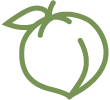An attractive, highly disease-resistant apple, ideal for organic growers.
Pear Scab
Fruits Affected
Also See
Fruit Tree Diseases and Pests: An IntroductionList of Common Fruit Tree Diseases and Pests
Pear scab is caused by the fungus Venturia purina. It is similar to apple scab but less common and less persistent. The fungus that causes pear scab overwinters in twigs and infected leaves on the ground.
Symptoms
Spots on leaves; fruit malformation and spots on fruit that develop into dark cracked areas.
Organic Treatments
The severity of a pear scab infection will depend on the amount of infectious material in the environment. For this reason, clearing and mowing or disposing of fallen leaves and other material in the growing is the best and easiest prevention. If you know that pear scab is an issue in your area, consider planting varieties that have demonstrated some resistance, such as Harvest Queen, Harrow Gold, and Harrow Delight. Varieties that are especially susceptible, such as Duchess and Flemish Beauty should be avoided if pressure is high. In some conditions a fungicide may be necessary. Sulfur will be moderately helpful.
Conventional Treatments
Merivon, Mankozeb, and Sovran are all effective. Rotate the chemistry to avoid resistance buildup.
Disease Cycle
Pear scab is caused by the fungus Venturia purina. It is similar to apple scab but less common and less persistent. The fungus that causes pear scab overwinters in twigs and infected leaves on the ground. Spores are released during spring rains, and they are wind or water borne to new plant material. A new infection will occur if temperatures range between 55°F and 75°F and the surface is wet for nine or more hours. The fungus will continue to spread as long as conditions are favorable.
Infection will appear on leaves as pale yellow spots that will darken to olive or brown as they age. The underside of the spots may have a velvety appearance as secondary spores become visible. Badly infected leaves may yellow and drop. The infection has a similar appearance on fruit, with spots tending toward the calyx end appearing about a month after fruit set. The spots will darken, sometimes cracking, and infected fruit may be misshapen. Lesions can also appear on growing shoots.
For more information, see the New England Tree Fruit Management Guide.
Featured Products
A few things we're loving right now...
A full-flavored, freestone white peach.
One of America's oldest apples, good for storage, baking, and cider.
A widely-grown, large, yellow-fleshed nectarine.












